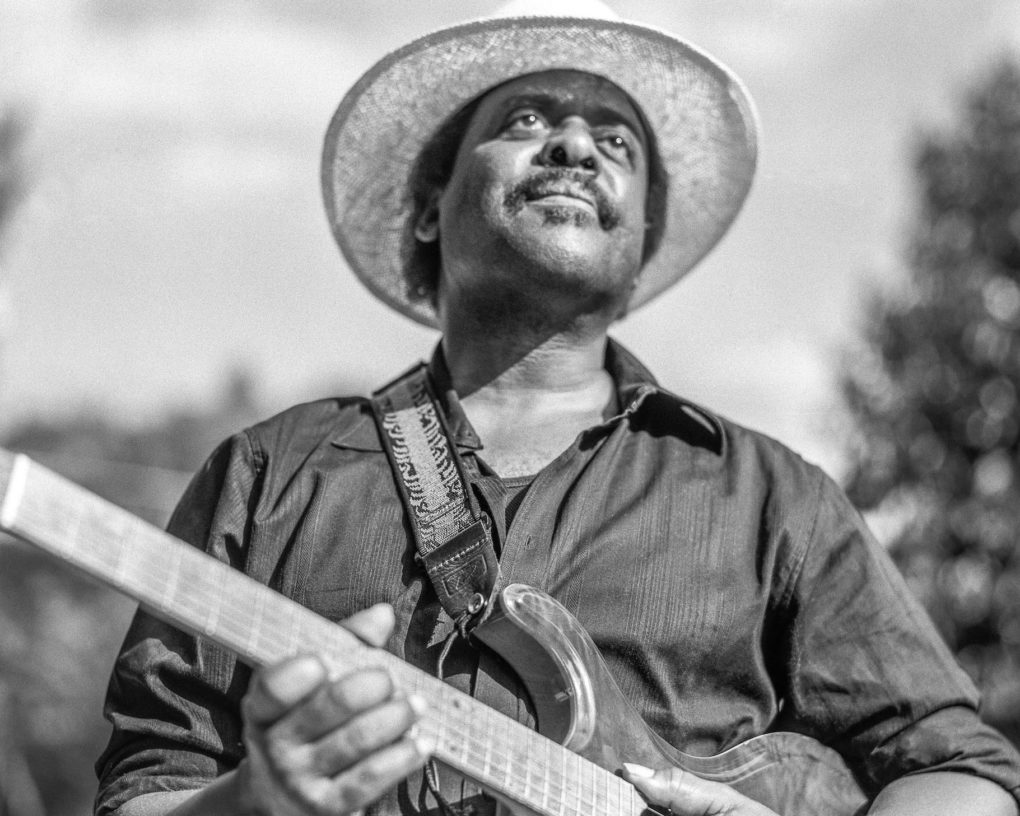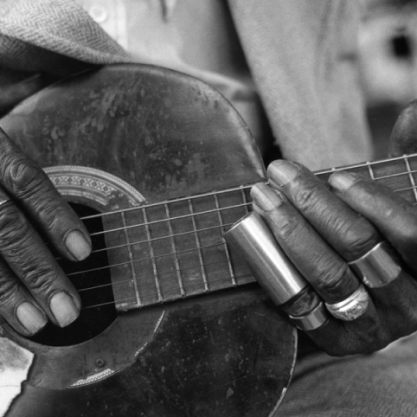Singing Through the Storm

By Tess Stogner.
On a warm September evening in 1999, in the coastal town of Beaufort, South Carolina, Cool John Ferguson walked out to the waterfront. He traveled alone, and the walkway was empty of its typical bustle of fishermen and passersby. Gazing out at the sea, he watched the clouds gather on the horizon in the darkening sky. Minutes later, the mist came in and the rain began. When the wind intensified, he knew it was time to take shelter. “Well, here comes Floyd,” he said to himself, turning away from the ocean to travel back to his home, pick up his guitar, and write.
Hurricane Floyd prompted what was then the largest evacuation in peacetime in US history as 2.6 million people living on the southeastern coast fled their homes. Cool John was not one of these millions; he chose to stay behind and wait out the storm.
“Beaufort is my hometown, and I didn’t know if Floyd was going to destroy it,” Ferguson explains. “I wanted something to remember this by.” In the uncertainty of what was to come, he turned to music. “Here Comes Floyd” is what he created from the chaos.
The song’s composition itself, “Here Comes Floyd,” captures the raw intensity of the approaching hurricane. Cool John used three different guitar tracks and a bass track to tell the story. The lead guitar sets the tone and narrates the journey through the storm, while heavy metal backup rock power chords add depth and reinforce the sense of Floyd’s ferocity and relentlessness. Through his artistic interpretation, Cool John sought to encapsulate the emotions and uncertainty surrounding the impending disaster.
There’s a strong tradition of blues artists acting as the record-keepers in these moments of collective turmoil. Memphis Minnie and Joe McCoy’s “When the Levee Breaks,” written in the aftermath of the 1927 Great Flood of Mississippi, was famously covered by Led Zeppelin over four decades later. That same disaster also brought Bessie Smith to write “Backwater Blues,” and Barbecue Bob to pen “Mississippi Heavy Water Blues.”
Most of us can remember where we were when Hurricane Katrina hit New Orleans in August 2005. Music Maker Artist Alabama Slim witnessed the disaster firsthand and remembers it as though it were yesterday.
“My wife was working at the Monteleone Hotel. She was a steamster there. When it started getting dark, my wife, she got a suite for us at the Monteleone, on the third floor. And it started to rain, the wind was blowing. I called my cousin, Little Freddie King. I said, ‘Man, you got to come out from down there.’ I said, ‘My wife got a room up here for us,’ he said, ‘No, I’m going to try to ride it out.’ Cause he was living next to the St. John Bayou there. And I said, ‘Man, you better come on and get on up here.’ It was getting a little rough. I said, ‘Man, you better get here. You ain’t got but 15 minutes to make it here.’ And he got on that bicycle and he was there in 10 minutes,” Slim recollects with a chuckle.
“That’s when the storm came on down, man. I mean, it came down. I go to the window and I peek. Woo, nothing but wind and rain. Wind and rain. And that morning, we looked out and everything was flooded,” he recalls. “That storm was rough. Little children was crying. There was old people, sick people, blind people.”
The devastation of the storm itself was multiplied by the US government’s controversial response in its aftermath. The storm cost $108 billion in property damage, and an estimated 1,200 people died. An assessment from the state of Louisiana confirmed that just under half of these deaths resulted from chronic disease exacerbated by the storm, and a third of the deaths were from drowning. An estimated 400,000 people were permanently displaced.
In the days and weeks that followed, people remained stranded in a city that was 80% submerged in water. Slim, Freddie and his wife found a way to leave the hotel after several days, and lived with family in DeSoto, Texas for 11 months following the storm. When they finally returned, the city was a shadow of its former self.
“Some places have recovered, but some places are not there,” says Slim. “A lot of places, Katrina just wiped it out. And now they finally put something else there. The people that’s here, they remember them.”
The calamity and collective trauma of Katrina is beyond words. Where these fail, music speaks. Slim penned “The Mighty Flood” with Little Freddie King, a testament to what his community endured. As Slim puts it, “I’m explaining the truth to the people. I mean, it’s in my heart, in my mind. And I just have to come out with it.”
As people searched for a place to find shelter, 250,000 of New Orleans residents fled to Houston. Leonard “Lowdown” Brown, a Houston resident and Music Maker Artist, remembers the scene. “They were bringing people to Houston by the bus loads,” Brown recalls.
The migrants brought New Orleans culture with them in the years to follow, opening restaurants and music clubs inspired by the Creole and Cajun culture of the Crescent City. These reverberations from Katrina inspired Leonard to write his song, “Find a Bridge,” which is influenced by the zydeco sounds of Clifton Chenier and Buckwheat Zydeco.
“I didn’t really know that much about Zydeco, but when I came to Houston in ‘81, I heard it and learned a lot about the French culture; how it’s really a Cajun style of music that when Black people got involved with it, they put their little twist on it and it became Zydeco. Zydeco is basically a kind of blues with an accordion rather than a guitar, and a little bit of a different beat.”
As for the content of the lyrics, “Find a Bridge” addresses the displacement of these Louisianians and shapes it into a universal experience. “I wrote it about people trying to escape the bad situation they’re in, wanting to get back home, and get things back to normal,” Leonard shares.
The upbeat tune is a memento; music, in its ephemeral nature, can travel with us, when our tangible treasures are lost.
We are currently facing an unprecedented level of human-induced climate change. Scientific studies indicate that extreme weather events such as heat waves and large storms will become more frequent or more intense in the coming decades. As this becomes the reality, we need to find ways of developing resilience to confront these rapid changes and disruptions.
Music transmutes an individual’s experience, of pain, uncertainty, loss, into a collective offering. It can show us the pathway from sorrow to dancing, from fear to faith, from brokenness to healing. How do we show our appreciation to those who blaze trails for us through the wreckage and wilderness?

Get involved
& give back
The Music Maker Foundation is a 501(c)(3) nonprofit organization that depends on thousands of supporters. Together, we work to meet the day-to-day needs of the artists who create traditional American music, ensure their voices are heard, and give all people access to our nation’s hidden musical treasures. Please contribute or shop our store today.
